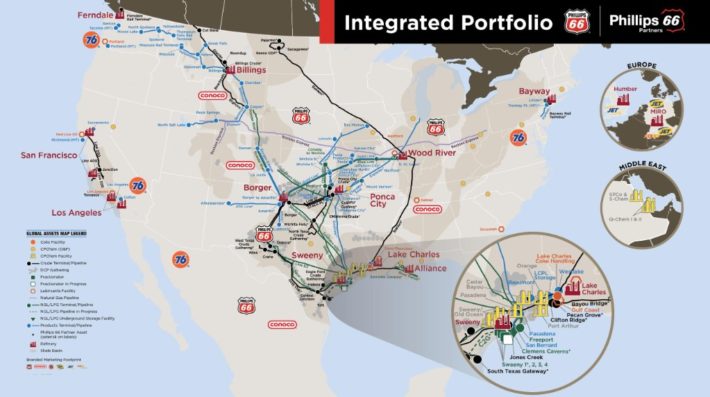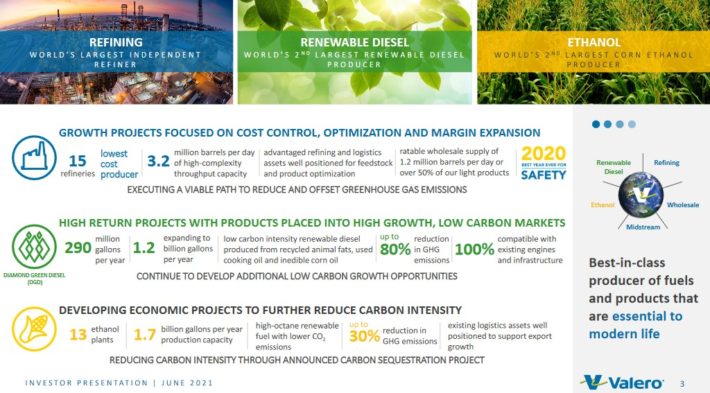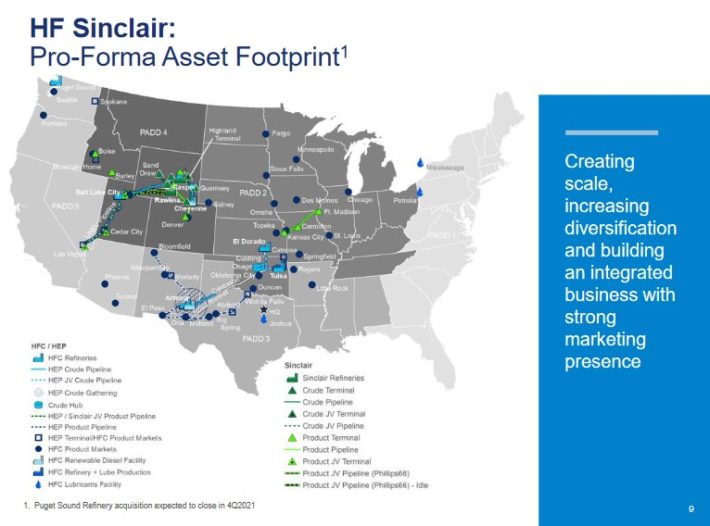Updated on August 26th, 2021 by Bob Ciura
Oil refiners have enjoyed an impressive rally since the start of 2021, thanks to the gradual reopening of the economy along with higher demand for oil. As a result, certain oil refiners have outperformed the market in this time period.
Year-to-date, the S&P 500 (as measured by SPY, the major ETF that tracks the market index) generated total returns of 21%, whereas the big 4 oil refiners have generated the following returns:
- Phillips 66 (PSX) year-to-date total returns: 7%
- Valero Energy (VLO) year-to-date total returns: 22%
- HollyFrontier (HFC) year-to-date total returns: 23%
- Marathon Petroleum (MPC) year-to-date total returns: 46%
Given the impressive rally of the refiners, investors should be extra careful in their choices, as a great portion of the future growth has already been priced in. With oil prices continuing to rise, this holds true for much of the energy sector.
You can see our full list of nearly 250 energy stocks (along with important financial metrics like dividend yields and payout ratios) by clicking on the link below:
In addition, the price of oil has enjoyed an impressive rally, as WTI Crude is near $68 per barrel, almost double the price last year. A high oil price adversely affects the demand for oil products and thus it usually hurts refining margins. Nevertheless, it is a risk factor to consider for the future.
In this article, we will compare the expected 5-year returns of the four major refiners by summing their EPS growth, their dividends and their expected P/E expansion or contraction. Expected total return data comes from our more than 700 stocks (and growing) Sure Analysis Research Database.
Table Of Contents
You can instantly jump to any specific section of the article by clicking on the links below:
- Industry Overview
- U.S. Oil Refiner Stock #1: Phillips 66 (PSX)
- U.S. Oil Refiner Stock #2: Valero Energy (VLO)
- U.S. Oil Refiner Stock #3: HollyFrontier (HFC)
- U.S. Oil Refiner Stock #4: Marathon Petroleum (MPC)
Industry Overview
Of the 4 major U.S. oil refiners, all but one (Phillips 66) have outperformed the S&P 500 so far this year. There are three major reasons behind the impressive rally of certain refiners.
First, demand for oil is recovering in 2021 after a huge decline last year amid the coronavirus pandemic. Second, after having paid hefty amounts on biofuel blending costs for years, there are reports the Biden administration could provide some relief to the U.S. refiners from the biofuel blending mandate.
While the magnitude of the relief and its timing are still unknown, the benefit is expected to be significant.
Finally, refiners will greatly benefit from the new international marine standard, which came into effect in 2020. According to the new standard, all vessels will burn low-sulfur diesel instead of heavy fuel oil. As a result, the demand for diesel will greatly increase and will thus provide a boost to refining volume.
With that said, the major 4 U.S. oil refiner stocks are discussed in greater detail below.
U.S. Oil Refiner Stock #1: Phillips 66 (PSX)
Phillips 66 was spun off from ConocoPhillips (COP) in 2012. Phillips 66 operates in four segments:
- Refining
- Chemicals
- Marketing
- Midstream
It is a diversified company with each of its segments behaving differently under various oil price scenarios.
Source: Investor Presentation
In early August, Phillips 66 reported (8/3/21) financial results for the second quarter of fiscal 2021. Refining margins improved but the benefit was offset by higher RIN costs. On the other hand, the chemical segment posted record earnings thanks to impressive margins and high utilization.
As a result, the company switched from an adjusted loss of –$1.16 per share in the first quarter to an adjusted profit of $0.74 per share. The pandemic has begun to subside thanks to the distribution of vaccines, though the propagation of the delta variant has raised some concerns for the recovery of the energy sector. Nevertheless, Phillips 66 is more defensive than pure refiners in the adverse scenario.
Growth projects in the oil industry take many years to start bearing fruit and hence there is a great lag between capital expenses and their resultant cash flows. Fortunately for the shareholders of Phillips 66, the company is currently in the positive phase of its cycle.
While it has greatly reduced its capital expenses in recent years, it has begun to reap the benefits from its huge investments in 2014 and 2015, when it invested a total of $9.5 billion. In addition, management is well known for its discipline to invest only in high–return projects.
Given this, it is reasonable to expect at least 6.0% average annual EPS growth over the next five years.
Based on expected EPS of $7.03 for 2021 (equal to the 5-year mid-cycle average), the stock is now trading at a P/E of 10.1, which is below our fair value P/E of 12. Expansion of the P/E multiple could boost annual returns by 3.5% per year over the next five years. Shares also yield 5%, making Phillips 66 a high dividend stock.
Overall, the stock is likely to offer a 14.5% average annual return over the next five years.
U.S. Oil Refiner Stock #2: Valero Energy (VLO)
Valero is the largest independent petroleum refiner in the world. It owns 15 refineries in the U.S., Canada and the U.K. and has a total capacity of about 3.2 M barrels/day. It also has a midstream segment, Valero Energy Partners LP, but its contribution to total earnings is under 10%. Valero should be viewed as a nearly pure refiner.
Source: Investor Presentation
In late July, Valero reported (7/29/21) its financial results for the second quarter of fiscal 2021. Thanks to the ongoing recovery from the pandemic and the resultant improvement in refining margins, the refining segment switched from an operating loss of –$383 million in last year’s quarter to operating income of $361 million.
In addition, Valero produced a record amount of renewable diesel and thus this segment nearly doubled its operating income, to an all–time high level.
As a result, Valero switched from an adjusted loss of –$1.25 per share in last year’s quarter to a profit of $0.48 per share. Valero is doing its best to accelerate the completion of growth projects related to renewable diesel.
Valero has a competitive advantage over its peers, namely the high complexity of its refineries. Its high complexity renders it the most resilient during downturns, as the least complex refineries are hurt the most during such periods due to their lack of flexibility.
In order to calculate the future return of Valero, we have used its mid–cycle earnings–per–share of $6.19, which is the 5–year average until 2019. We view the headwind from the pandemic as temporary and expect the demand for oil
products to continue to recover in the upcoming quarters.
Moreover, Valero has a promising pipeline of growth projects for the next three years. These projects aim to lower carbon intensity and improve refining margins. We thus expect the refiner to grow its earnings–per–share at a 4.0% average annual rate off its mid–cycle level until 2026.
On the other hand, the stock is now trading at a P/E of 10.6, which is slightly higher than our fair value estimate (also the 10-year average P/E) of 10.4. Valuation changes will therefore not substantially contribute to total returns. Still, expected EPS growth of 4% while the dividend yields 6%. Total returns are expected to slightly exceed 10% per year.
U.S. Oil Refiner Stock #3: HollyFrontier (HFC)
HollyFrontier was formed with the merger of two independent U.S. refiners, Holly Corporation and Frontier Oil, in 2011. The company operates in three segments:
- Refining
- Lubricants
- Holly Energy Partners (HEP), a midstream entity
Nevertheless, HollyFrontier should be viewed largely as a refiner. The refining segment generates ~90% of the total operating income of the company.
Source: Investor Presentation
In early May, HollyFrontier reported (5/5/21) financial results for the first quarter of fiscal 2021. The pandemic continued to pressure the company, as it reduced the refining margin by –28%, from $11.06 to $8.00 per barrel, due to poor demand for refined products. Refining margins were also squeezed by the aggressive production cuts of OPEC and Russia, which have led to a full recovery of the oil price to pre–COVID levels.
On the other hand, the lubricant division nearly tripled its EBITDA, to an all–time high of $94.9 million, thanks to strong base oil margins and thus offset the poor results of the refining segment. As a result, HollyFrontier posted a flat loss per share of –$0.53. We expect the refiner to recover in the second half of the year thanks to the massive vaccination program underway.
Moreover, HollyFrontier is highly sensitive to the discount of WTI to Brent, which has narrowed due to the collapse in the U.S. shale oil production. That said, we expect shale oil production to grow significantly later this year and thus enhance the discount of WTI to Brent. Shale oil production is already in the early stages of recovery thanks to the rally of the oil price.
On May 5th, 2021, HollyFrontier announced that it has agreed to buy the Puget Sound Refinery from Shell for $350 million. The company will fund the acquisition via the suspension of its dividend for one year and cash on hand.
Given the above mentioned catalysts, we believe it is reasonable to expect it to grow its EPS by about 3% per year over the next five years. On the other hand, the company does not pay a dividend.
The stock is now trading at a P/E of 8.2, which is lower than its historical average P/E of 10.3. Therefore, if the stock reverts to its average valuation level in the next five years, it will incur a 4.7% annualized return from P/E expansion.
Overall, HollyFrontier is likely to offer a 7.7% average annual return over the next five years. This is a decent enough expected return, but not enough to warrant a buy recommendation.
U.S. Oil Refiner Stock #4: Marathon Petroleum (MPC)
After the acquisition of Andeavor Logistics in October 2018, Marathon Petroleum has become the largest U.S. refiner, with 16 refineries and a refining capacity of 3.1 million barrels per day. It also has a marketing system that includes ~6,800 branded locations. In addition, MPC owns MPLX LP (MPLX), a midstream Master Limited Partnership, which has gathering and processing assets as well as pipelines for crude oil and light products.
In early August, Marathon Petroleum reported (8/4/21) financial results for the second quarter of fiscal 2021. Thanks to the massive vaccine rollout and the resultant improvement in the demand for refined products, MPC began to recover from the pandemic.
The refining segment switched from an operating loss of –$1.5 billion in last year’s quarter to an operating profit of $224 million thanks to the expansion of its refining margin from $7.64 to $12.45. As a result, MPC switched from a loss of –$1.33 per share to a profit of $0.67 per share. A return to profitability was also helped by the company’s aggressive cost cuts.
Source: Investor Presentation
During the quarter, MPC completed the sale of its Speedway business to 7–Eleven for after–tax proceeds of $16.5 billion in cash. The deal includes a 15–year fuel supply agreement for about 7.7 billion gallons of fuel per year. MPC will use the proceeds to reduce its debt and will also return $9 billion to shareholders via share repurchases. The amount of share repurchases is massive, as it can reduce the share count by 25% at the current stock price.
MPC is properly positioned to benefit from the new marine rules. Thanks to a series of past investments, the refiner can upgrade about 600,000 barrels per day of low–value residue to diesel. We expect the energy market to continue to recover from the pandemic thanks to the massive vaccination program that is underway.
However, due to the sale of the Speedway business, we expect MPC to grow its earnings–per–share only 1.0% per year on average off its mid–cycle level (average 2015–2019) of $4.59.
On the other hand, Marathon is now trading at a P/E of 12.7, which is much higher than its historical average of 10.7. If the P/E ratio declines from 12.7 to 10.7, the stock would incur a 3.4% annualized P/E contraction.
Overall, the stock is likely to offer just a 1.6% average annual return over the next five years, as the 1% expected EPS growth and the 4% dividend yield will be partially offset by P/E contraction.
Final Thoughts
Thanks to the strong tailwind of the economic reopening and their strong business models, the Big 4 major U.S. refiners are likely to significantly grow their EPS in the next five years. Several refining stocks have outperformed the S&P 500 to start the year, which could make investors hesitant to buy. Fortunately, we still see them as undervalued, with strong total returns expected through their future EPS growth, rising P/E multiples, and dividends.
In the comparison of three of the major refiners, the dividend yield did not differentiate them significantly. The outlier was HollyFrontier, which suspended its dividend this year. Meanwhile, MPC has the lowest projected total return of the group, as it is the stock with the greatest expected P/E contraction (signaling it is the most overvalued).
On the contrary, Phillips 66 seems to have the most attractive mix of valuation, growth prospects, and dividend yield. As a result, PSX is the stock is likely to offer the highest 5-year return. Investors should also note that it is the only refiner that is highly diversified and can keep thriving even in a downturn of the refining margins.
In fact, if the price of oil continues to rise in the upcoming years, it will probably exert pressure on refining margins due to its pressure on the demand for oil products. In such a scenario, the midstream segment of Phillips 66 will offset most of the damage of the refining segment. Therefore, in such a scenario, Phillips 66 is likely to outperform its peers by a wide margin.









